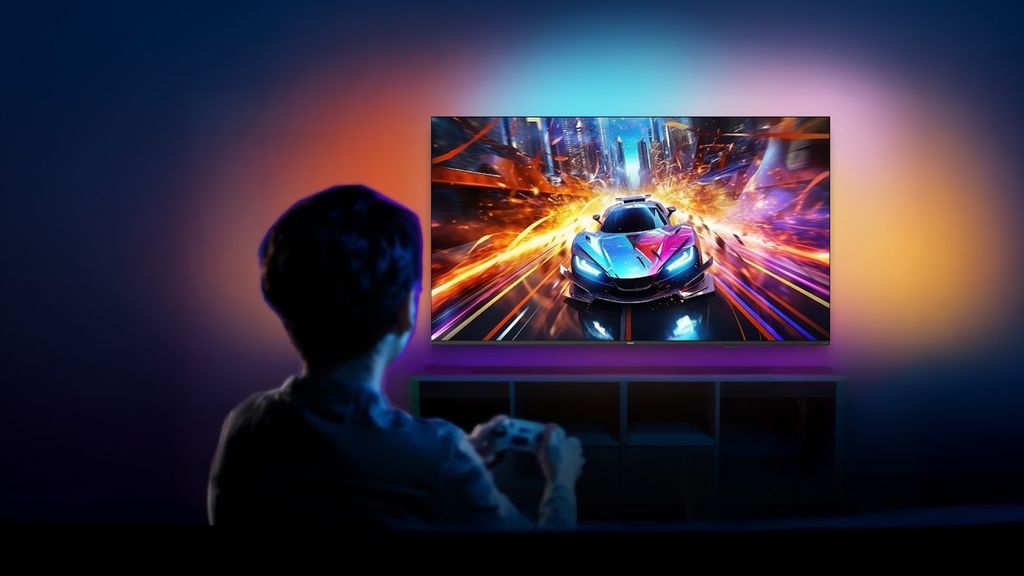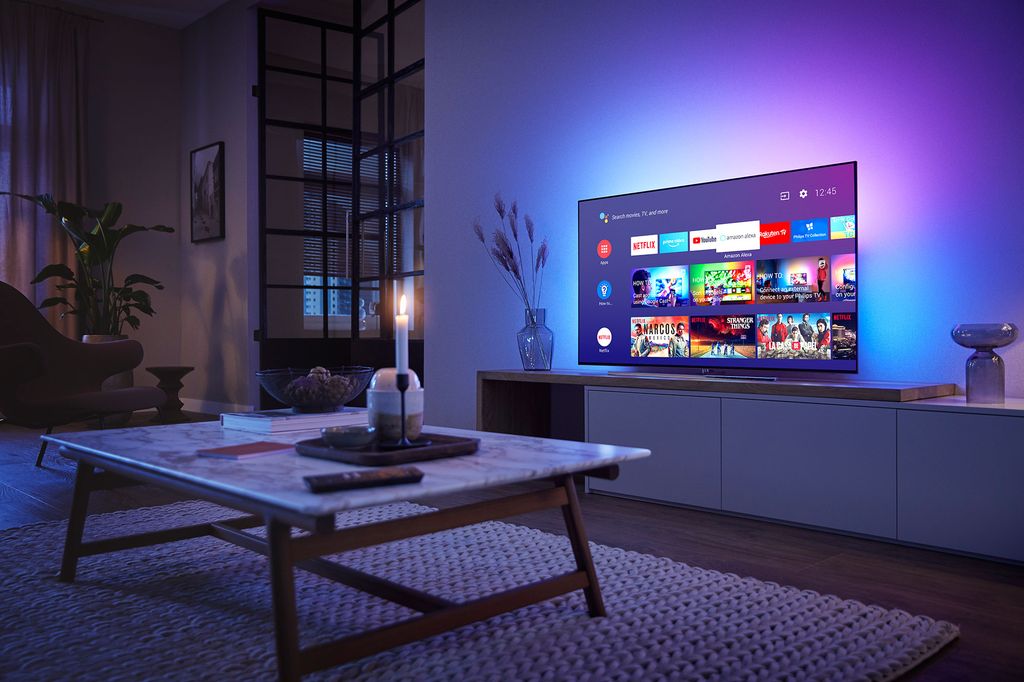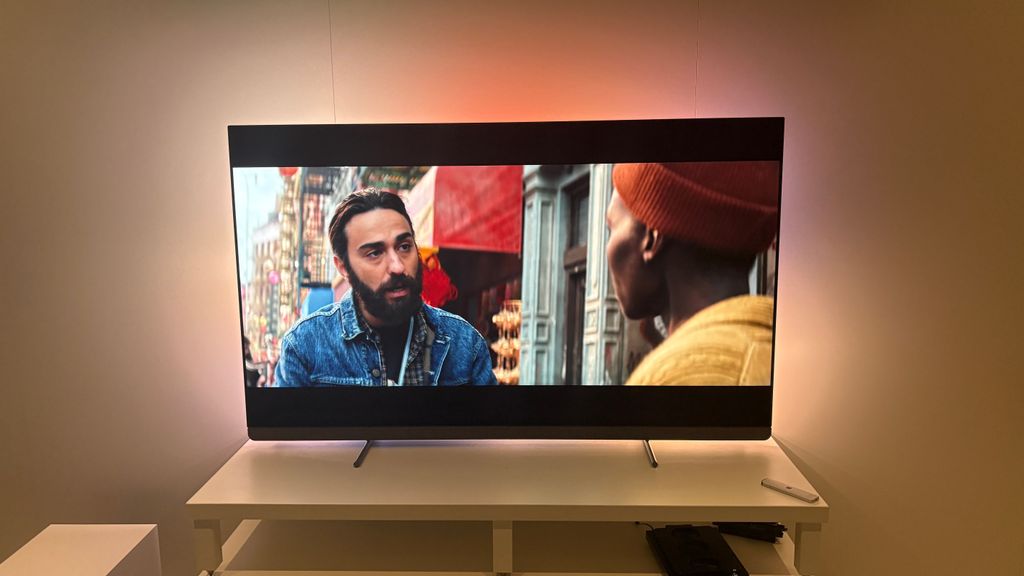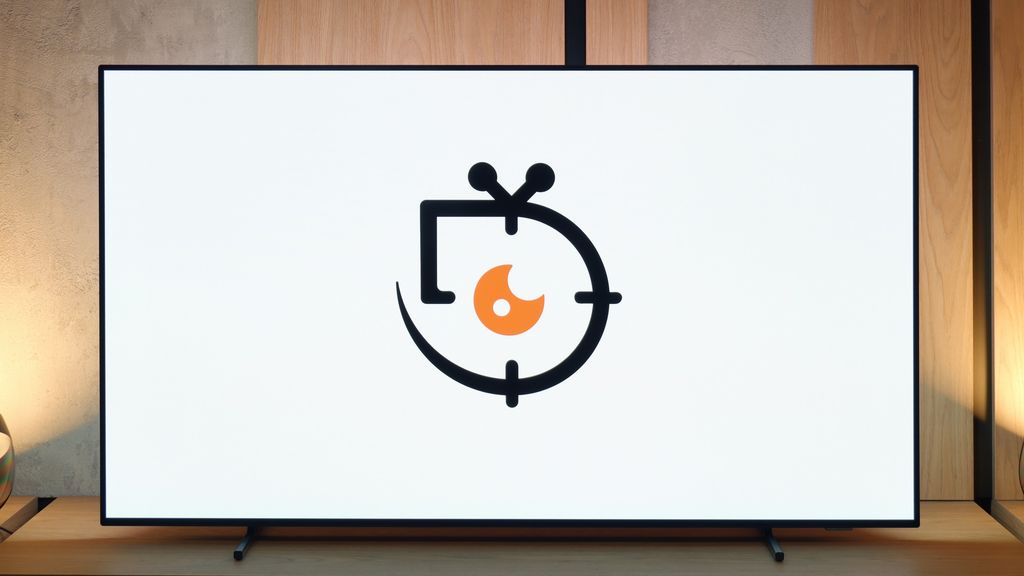4K Ultra HD QLED Resolution (3840 x 2160): QLED technology provides vibrant colours, high contrast, and incredibly sharp images, making content more realistic and full of depth.
Ambilight Technology: The three-sided Ambilight system emits a glow that adjusts to the content displayed on the screen, creating a more immersive viewing experience.
Pixel Precise Ultra HD Graphics Engine: Optimises the quality of displayed content, ensuring smooth motion and excellent image sharpness.
HDR10, HDR10+, and HLG Support: Support for various HDR formats guarantees better contrast and more accurate colour reproduction, resulting in a more realistic image.
TITAN OS Operating System: An intuitive and fast Smart TV system that allows access to popular streaming apps and customises the interface.
Dolby Atmos and DTS Technology: Delivers spatial sound, creating an immersive audio experience without the need for additional speakers.
Gaming Features: The television offers features such as variable refresh rate (VRR), automatic low latency mode (ALLM), and Game Bar, making it easier to manage settings while gaming.
Wi-Fi and Bluetooth Connectivity: Provides wireless internet access and connections to other devices, enhancing the functionality of the television.
HDMI 2.1 and USB Ports: Three HDMI ports and two USB ports allow for connection of a variety of external devices, such as consoles, media players, or USB drives.
- Matching (Score)
- Our verdict
- Competing TVs
- TV appearance
- Where to buy
- Contrast and black detail
- HDR effect quality
- Factory color reproduction
- Color reproduction after calibration
- Smoothness of tonal transitions
- Image scaling and smoothness of tonal transitions
- Blur and motion smoothness
- Console compatibility and gaming features
- Input lag
- Compatibility with PC
- Viewing angles
- Daytime performance
- TV features
- Apps
- Playing files from USB
- Sound
- Panel details
Philips PUS8209 Review
Available screen sizes:

Complete the survey to find out the result
Panel type: LCD VA Refresh rate: 60Hz Brand: PHILIPS Resolution: 3840x2160 System: Titan OS Model year: 2024
PHILIPS PUS8209 - Our verdict
5.3
Overall rating
The Philips PUS8209 is a model that stands out primarily due to its unique Ambilight system. The three-sided backlighting behind the television dynamically adjusts to the image, adding an exceptional atmosphere while watching movies or gaming. This solution, for which Philips is renowned, makes a difference and could be a great choice for those looking for something more unique for everyday use. In terms of picture quality, the television performs quite well, especially in this price range. The VA panel provides solid contrast and decent black levels, which is particularly effective in the evenings in dimly lit rooms. Watching movies in such conditions is truly enjoyable, although the screen brightness (280 nits) leaves much to be desired – in bright rooms, the picture can look washed out, and HDR content does not impress. When it comes to gaming, the PUS8209 also has a few advantages. Support for VRR, ALLM, and a low input lag of 13 ms makes gameplay smooth and responsive. Of course, this is not hardware for advanced gamers, but for those who occasionally pick up a controller, it should suffice. The biggest downside is the operating system, Titan OS. Many popular apps are missing, and the interface doesn't always run as smoothly as one would like. The remote control, which requires pointing at the television, can be frustrating, especially in situations where quick access is expected. In summary: the Philips PUS8209 is a television that works well for basic applications. Ambilight adds uniqueness and enhances the atmosphere while watching. In everyday use or occasional gaming, it does the job, but its limitations – particularly in screen brightness and operating system – may be problematic for more demanding users. If we are looking for straightforward equipment with an unusual visual addition, this model is worth considering.
Advantages
High native contrast
Three-sided Ambilight system – unique backlighting for the wall behind the TV that enhances immersion while watching
Low input lag – around 13 ms
Has essential features for gamers - VRR and ALLM
Support for Polish characters and subtitle customization – built-in player allows for changing the colour and size of the font
Support for Dolby Atmos and DTS – wide range of supported audio codecs
Disadvantages
Titan OS operating system – limited number of applications
Poor brightness (280 nits) – issues with viewing in bright conditions
Poor viewing angles – typical of VA panels,
Issues with font rendering
Movies and series in UHD quality
5.4
Classic TV, YouTube
6.1
Sports broadcasts (TV and apps)
4.9
Gaming on console
6.6
TV as a computer monitor
2.0
Watching in bright light
4.4
Utility functions
4.7
Apps
6.2
Sound quality
5.0
Complete the survey to find out what fits your preferences
PHILIPS PUS8209 - Competing TVs in this price range
PHILIPS PUS8209 - TV appearance
HDMI inputs: 3 x HDMI 2.0, 0 x HDMI 2.1 Outputs: eARC (HDMI), ARC (HDMI) Network Interfaces: Wi-Fi 2.4GHz, Ethernet (LAN) 100Mbps
Build quality: Average
Stand type: Legs
Bezel color: Graphite





Stand: Fixed
Flat design: No
Accessories: Stand
Buy at the best price
Select size:
PHILIPS PUS8209 - Contrast and black detail
6.6/10
Local dimming function: No

Result
8,050:1

Result
7,300:1

Result
10,200:1

Result
9,050:1

Result
8,200:1
Visibility of details in the lights:

Philips PUS8209 positively surprised us in terms of contrast, which is quite solid for its price class. Thanks to the use of a VA panel, it managed to achieve a contrast ratio of 8000:1, which is considered a very good result in this price category. In tests using scenes from the film Oblivion, the television performed well, offering visible light separation. Three independent light sources in the test scene were reproduced without major issues. Similarly, in the case of the film Sicario 2, the black levels, while not perfect, present reasonably well, allowing for the distinction of details in the darker areas of the image. The lack of local dimming technology is noticeable, however, the manufacturer has implemented a "global dimming" feature. This mechanism allows the television to automatically darken or brighten the entire screen depending on the content, which somewhat improves the perception of contrast. Philips PUS8209 offers solid contrast and decent results in tests. Although it lacks the precision of local dimming, its capabilities at this price point are satisfactory and will please most users.
Halo effect and black detail visibility:
PHILIPS PUS8209 - HDR effect quality
3.8/10
Supported formats: HDR10, HDR10+, HLG Color gamut coverage: DCI P3: 91.4%, Bt.2020: 67.0%
Luminance measurements in HDR:

Result
231 nit

Result
268 nit

Result
278 nit

Result
274 nit

Result
281 nit
Unfortunately, this is where the problems start. A maximum brightness of 280 nits is definitely too low to experience the true effect of HDR. In practice, the image resembles standard SDR more, so it's hard to talk about deeper visual experiences. On the plus side, the colour gamut coverage is 91.4% DCI-P3, which will be sufficient for most films. It's also worth noting that the image is stable and there are no issues with sudden brightness or colour changes. Overall, HDR on this television is more of a formality than an actual added value. If we're looking for genuine HDR emotions, this model may not meet expectations.
Scene from the movie “Pan” (about 2800 nits)

Scene from the movie “Billy Lynn” (about 1100 nits)

We’re checking how the television handles adaptation to very demanding HDR scenes designed for high brightness values. In the first scene from the film Mr, the image, for this class of television, looks quite good. The darkest details are somewhat brighter than they should be, but the overall perception remains positive, and the tone of the scene is correct. On the other hand, in the film Billy Lynn, some problems can be noticed. Highly contrasting elements, such as fireworks effects, can be blown out and blend into a uniform whole. Aside from these shortcomings, the tonal quality of the image in the remaining parts is maintained at a good level.
HDR luminance chart:
HDR luminance
The television supports both static HDR10 and dynamic HDR10+, which theoretically should offer differences in image quality depending on the type of metadata used. However, in practice, due to low maximum brightness, it is difficult to see clear differences between dynamic and static metadata. It is possible that Dolby Vision implementation would improve HDR quality, but unfortunately this model lacks that format.
Static HDR10

Dynamic: HDR10+

Factory color reproduction
6/10
Philips PUS8209 offers many picture modes, but the best of them, without a doubt, is the Filmmaker mode. Despite its proud name, it has its distinct problems. For HD content, the white balance is characterised by a strong dominance of red, causing the image to be significantly warmer than it should be in reality. The brightness characteristic (gamma), although correct in mid-tones, has serious issues at the beginning and end of the graph. Drops in shadows result in a loss of detail in dark areas, and spikes in bright areas make some elements look unnatural.
For high-quality content in 4K HDR, the situation reverses. In this case, blue dominates, leading to an artificial image boost effect, reminiscent of unnatural retail settings. Such an image looks unappealing and does not align with the creators' intentions. An additional problem is the EOTF curve, responsible for brightness in HDR materials. It deviates significantly from the reference graph, causing the image to appear too dark, stripping depth and detail from HDR content.
Against this backdrop, the errors in the Color Checker test and deviations in colour palette reproduction are exceptionally large, which further negatively affects the overall image quality. The Filmmaker mode, while the best among those available, requires substantial corrections to truly convey the full vision of the director.
Color reproduction after calibration
8.3/10
After calibration, the white balance for HD and 4K content has significantly improved. While we haven't achieved a perfectly flat characteristic, the result is definitely better than before. The image on the television no longer appears either artificially warm or overly cold, which significantly enhances the naturalness of the displayed content. The brightness characteristic (gamma) has also been adjusted – the most significant issues at the beginning and end of the graph have been mitigated. The EOTF curve, which is responsible for brightness in 4K HDR materials, has been stabilised, eliminating problems with excessive dimming of the image. In the colour palette test, some imperfections can still be seen due to the average coverage of the wide colour gamut, which is a limitation of the hardware itself. Nevertheless, the final result is clearly better than pre-calibration – the image looks more natural and approaches the expectations for Filmmaker mode.


PHILIPS PUS8209 - Smoothness of tonal transitions
6.5/10
Philips PUS8209 presents a decent gradation in bright scenes, where the tonal transitions are smooth enough not to be jarring. Unfortunately, in darker scenes, such as red water, the TV struggles noticeably. Issues with blending shades and a lack of precision in reproducing subtle colour differences are very apparent here.








Image scaling and smoothness of tonal transitions
5.5/10
Smooth transition function
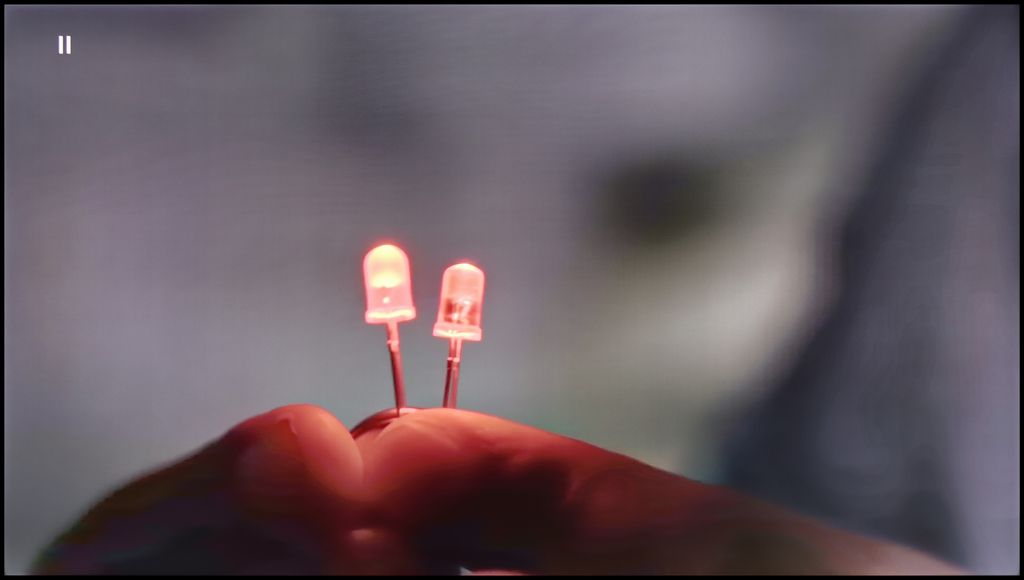
Image without overscan on the SD signal

The television offers a “Distortion Reduction” feature that effectively improves the gradation of tonal transitions, particularly when set to the minimum level. Unfortunately, this comes at a cost – the feature also smooths out details like material textures. On the plus side, it’s worth noting that the operation of this option does not negatively affect the film grain, which remains intact.
As for image scaling (upscaling), the television generates a plastic, soft image that generally looks pleasant. However, in the background, issues with aliasing of certain elements, such as branches or small details, can sometimes be noticed, which may decrease the quality of the reception. Despite these minor imperfections, the overall experience of scaling is satisfactory.
PHILIPS PUS8209 - Blur and motion smoothness
3.8/10
Maximum refresh rate of the panel: 60Hz
Film motion smoothing option: No
Blur reduction option: No
BFI function 60Hz: No
BFI function 120Hz: No
The 60 Hz panel in the Philips PUS8209 is mainly suited for watching movies, but here you can also feel a certain shortcoming. The television does not offer any motion smoothing that would allow you to adjust the fluidity of the picture to individual preferences, which for some users may be disappointing.
Blur (native resolution, maximum refresh rate):



When it comes to motion blur, the television performs moderately. The issues are not very bothersome, but they are noticeable – especially in tests where there is a slight stretching of objects, such as the distinctive “Ufoludek” in the motion fluidity test. Although motion blur does not interfere with everyday use, more demanding users may notice it.
PHILIPS PUS8209 - Console compatibility and gaming features
4.7/10
ALLM: Yes
VRR: Yes
VRR range: 48 - 60Hz
Dolby Vision Game Mode: No
Correct implementation of HGIG: No
1080p@120Hz: No
1440p@120Hz: No
4K@120Hz: No
Game bar: Yes


Philips PUS8209 offers basic features useful for gamers, such as variable refresh rate (VRR), automatic low latency mode (ALLM), and Game Bar, which makes managing settings easier.
Unfortunately, due to the 60 Hz panel, the TV will not meet the expectations of more demanding gamers who are looking for higher fluidity and precision of image. Additionally, this model does not support any HDR mode dedicated to gaming, such as HGiG or Dolby Vision, which further limits its capabilities in this regard.



PHILIPS PUS8209 - Input lag
10/10
Input lag in the Philips PUS8209 is one of its strongest points. With a value of around 13 ms, the TV provides a very quick response time, which should satisfy most gamers, both casual and more advanced. Such a result allows for comfortable gameplay even in dynamic games.
| SDR | HDR | Dolby Vision |
|---|---|---|
| 1080p60: 13 ms | 2160p60: 13 ms | |
| 2160p60: 13 ms |

PHILIPS PUS8209 - Compatibility with PC
2/10
Chroma 444 (maximum resolution and refresh rate): Yes
Font clarity: Good
Readability of dark text and shapes: Poor
Input lag in PC mode (4K, maximum refresh rate): 13ms
Matrix subpixel arrangement: BGR
Max refresh rate: 60Hz
G-Sync: No
On paper, collaboration with a PC seems promising, particularly due to support for 4:4:4 chroma, which should ensure good font readability and detail reproduction. In practice, however, the television has significant issues with displaying text, especially on dark backgrounds, where the so-called pixelation is clearly visible, negatively impacting work comfort.
Additionally, the lack of support for technologies like G-Sync means that gaming smoothness when connected to a PC leaves much to be desired, making this model less attractive for users looking for a television for gaming on a computer.
PHILIPS PUS8209 - Viewing angles
2.1/10
Brightness drop at an angle of 45 degrees: 87%
The viewing angles on the Philips PUS8209 are poor, which is typical for a VA panel. When watched at an angle, the brightness of the image drops significantly, and the colours lose their depth, which can greatly affect viewing comfort, especially in larger groups or in an unusual setup of the television in relation to the viewer.
PHILIPS PUS8209 - Daytime performance
4.4/10


Panel finish: Satin
Reflection suppression: Average
Black levels during daytime: Very Good
The Philips PUS8209 features a satin screen coating that only moderately suppresses reflections, which may be inadequate in bright room lighting. However, the biggest issue is the low brightness at just 280 nits. In practice, this means that watching content during the day, especially in strong sunlight, can be a challenge as the picture appears too dark to provide comfortable viewing.
Panel brightness
Average luminance SDR
Philips PUS8209: 277 cd/m2
PHILIPS PUS8209 - TV features
4.7/10
System: Titan OS
System performance: Poor
- HDMI inputs: 3 x HDMI 2.0, 0 x HDMI 2.1
- Outputs: eARC (HDMI), ARC (HDMI)
- Network Interfaces: Wi-Fi 2.4GHz, Ethernet (LAN) 100Mbps
- TV reception: DVB-T, DVB-T2, DVB-S, DVB-S2, DVB-C
Classic features:
Recording to USB (terrestrial TV): No
Recording programming: No
Picture in Picture (PiP): No
RF remote control (no need to aim at the screen): Infrared
Backlit remote control: Yes
Teletext: Yes
Audio only mode: Yes
Bluetooth headphones support: No
Simultaneous Bluetooth headphones & TV audio: No
Smart features:
AirPlay: No
Screen mirroring (Windows Miracast): Yes
Voice search: Yes
Voice search in native language: No
Ability to connect a keyboard and mouse: Yes




Philips PUS8209 uses the Titan OS operating system, which, while simple to use, remains limited in terms of functionality. The available number of applications is small compared to more developed ecosystems like Google TV, which may be disappointing for users accustomed to broader capabilities. Additionally, the lack of support for AirPlay restricts compatibility with Apple devices, reducing the flexibility of the television in streaming content. The remote, though interesting, requires aiming at the screen, which may not appeal to everyone.
The absence of more advanced features such as PiP (Picture-in-Picture) or program recording further limits the device's capabilities in everyday use.
Philips PUS8209 is a television that catches attention with its interesting feature of a three-sided Ambilight system, which is a dynamic backlighting of the wall behind the television that adjusts its colours and intensity to the content displayed on the screen. This effect creates the impression of greater image depth and enhances immersion, especially in darkened rooms. Unfortunately, its potential is limited by the Titan OS operating system, which leaves much to be desired. The limited number of applications and the lack of support for popular features such as AirPlay can be a significant drawback for more demanding users. While Ambilight distinguishes this model from the competition, shortcomings in the operating system significantly affect the overall functionality of the television.
Sound connection options
HDMI audio:
Other audio outputs:
Wireless audio:
Supported audio formats (external HDMI eARC audio):
Dolby Digital Plus 7.1: Yes
Dolby True HD 7.1: Yes
Dolby Atmos in Dolby Digital Plus (JOC): Yes
Dolby Atmos in Dolby True HD: No
DTS:X in DTS-HD MA: Yes
DTS-HD Master Audio: Yes
Senior accessibility
Numeric keyboard on TV: Yes
Font size adjustment: No
Audio description: No
PHILIPS PUS8209 - Apps
6.2/10























PHILIPS PUS8209 - Playing files from USB
8/10

| Maximum photo resolution: | Supported photo formats: |
|---|---|
The built-in media player in the Philips PUS8209 performs well in everyday use. It smoothly handles Polish characters in subtitles and allows for adjustments to the colour and size of the font, which significantly enhances the comfort of using this feature. More demanding users may notice some limitations in the supported file formats, however, for most applications in everyday use, this player should be fully sufficient.
PHILIPS PUS8209 - Sound
5/10
-
Maximum volume
Supported codecs
(TV speakers)
Dolby Digital Plus 7.1
Dolby True HD 7.1
Dolby Atmos in Dolby Digital Plus (JOC)
Dolby Atmos in Dolby True HD
DTS:X in DTS-HD MA
DTS-HD Master Audio
The sound on the Philips PUS8209 can be described as average, typical for televisions in this price range. The 2x10 W speakers do not offer exceptional quality or depth; however, they are sufficient for everyday TV watching. On the plus side, it should be noted that there is a wide range of supported audio codecs, such as Dolby Atmos and DTS, which can significantly enhance audio quality when paired with external sound systems, like soundbars or home theatre setups.
Acoustic Measurements
No acoustic data
PHILIPS PUS8209 - Panel details
Software version during testing: TPN246E_V246.004.147.081
Subpixel Structure:

Panel uniformity and thermal imaging:
Backlight Type: PFS LED

Founder and originator of the "ChooseTV" portal

Journalist, reviewer, and columnist for the "ChooseTV" portal
See articles related to Philips PUS8209:
10/2/2025
4/3/2025
Shopping Reviews
The best Philips TVs of 2024 – these models are worth buying... 5/22/2025




